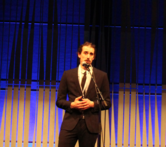Arctic Innovation Lab
ISE Students present ideas for better Arctic at Arctic Circle 2016

During last weekend's Arctic Circle Conference, many global leaders from government, NGOs, and the private sector came together in Reykjavik to debate the present status of the Arctic. Alongside UN General Secretary Ban Ki-Moon, First Minister of Scotland Nicola Sturgeon or Noble Laureate and visiting professor at ISE, Dr. William Moomaw, a large number of students from around the globe participated in the plenary and breakout sessions. A breakout session organized by the Harvard Kennedy School of Government and chaired by former ISE Director Halla Hrund Logadóttir focused on including the new generation of entrepreneurs, scientists and political leaders in the conference schedule.
In the Arctic Innovation Lab, twelve students from five different universities presented their ideas for a better Arctic in the form of two-and-a-half minute pitch. Attendees then had a chance to vote for their favorite idea before breaking into 12 round tables and further discuss one of the ideas presented. The idea with most votes would then in the end be crowned the winner of the innovation lab. Among the twelve students prese students from the Harvard Kennedy School (HKS), Fletcher School of Law and Diplomacy, University of Iceland and University of Greenland, where also two of our own students from the Iceland School of Energy.

Alaska native and first-year Sustainable Energy Engineering student, Riley Newman proposed that in order to render remote Arctic communities more self-sufficient, it is crucial to build up human capacities for operation and maintenance of their power generation equipment. The impracticality and cost of having to rely on outside help for maintenance of electrical infrastructure, especially with increasing deployment of renewable or clean technologies simply are unnecessary. Instead, setting up training programmes and providing education in regional hubs, may significantly increase the communities' abilities to be self-sustaining.

Alexander Moses, also a first year Sustainable Energy Engineering student, focused on eliminating diesel generation as the main electricity source in remote Arctic communities. His idea focused on creating ISO-shipping container sized wind turbines that could be deployed in the Arctic for off-grid generation in tiny remote communities. The idea of small-scale easily transportable renewable technologies is not new, deploying them in Arctic environments is. In order to brave the harsh environment and climate it will be deployed in, the task is now to make the entire set-up more sturdy and robust for the extreme arctic conditions. Alexander also proposed to add a set of batteries and flywheels that enable the balancing of the intermittent and fluctuating generation from wind turbines.
These are two of the twelve ideas presented. Oher ideas focused on other elements of future-proofing the Arctic by for example establishing a comprehensive Arctic treaty, the proposition of a new form of Arctic diplomacy that focuses on scientific communication rather than politics or a super-grid connecting Europe, with Iceland, Greenland and North America. In the end, the award for most innovative idea for a better Arctic did not stay in an Arctic country. Louis Bacon Environmental Leadership fellow Shauna Theel from the HKS lead the audience vote at the end of the session and was crowned the winner of the Arctic Innovation Lab for her idea of implementing electric vehicle car share-stations in Iceland on a broad scale.

At the conference Itself, the Iceland School of Energy was well represented by over 30 student representatives, a main breakout session, Future Arctic Energy scholar presence, and a premier booth on the presentation floor. ISE was happy to share the experience with fellow arctic institutions from Greenland, United States, Tromsø, Akuyeri, and the University Center of the Westfjords among many others.
Thank you very much to the Arctic Circle Secretariat for granting permission to use their photos for this article.
